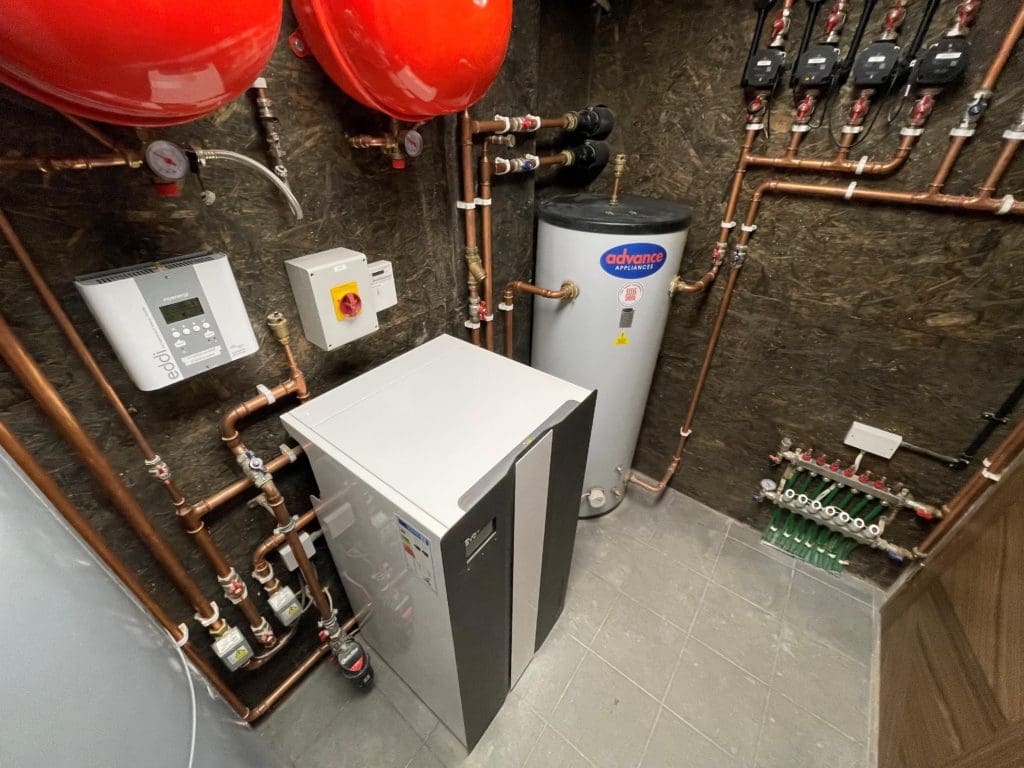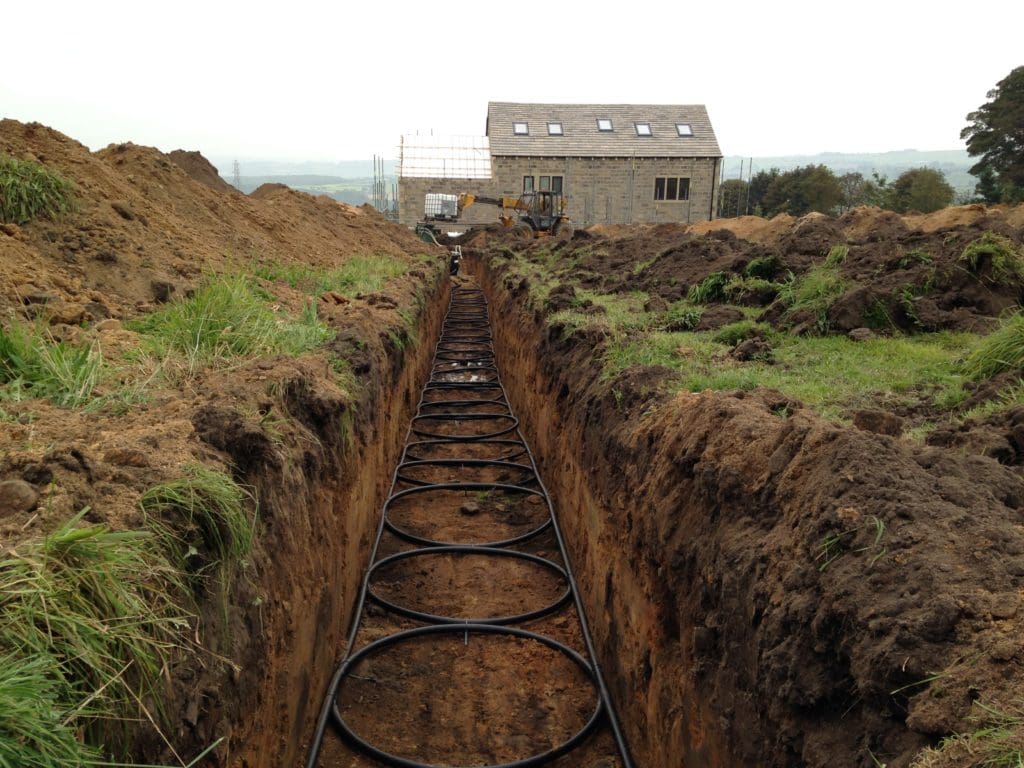
Why should homeowners be switching to heat pumps?
The last few decades have seen major technological changes – such as modern smart phones, digital streaming platforms, online shopping and Uber’s – that are now an intrinsic part of every-day life. In contrast, the way we heat our homes in the UK has roughly been as it is today for about half a century – with the majority having natural gas piped into them for use with a condensing gas boiler.
In order for the UK to deal with the threat of climate change, this has to change. Government has taken strong steps towards this; new boilers are set to be banned by 2035 and they have committed to installing 600,000 heat pumps every year by 2028. The impact of a mass switch away from fossil fuels will be radical; heat is the single biggest factor in UK domestic energy consumption, contributing one-third of greenhouse gas emissions.
Aren’t heat pumps a new technology, so not proven to be reliable yet?
Heat pumps are not a new technology (Kensa has been manufacturing ground source heat pumps since 1999), and the tech has been around since the 1800s). In fact, most people already have heat pumps in their homes. Standard refrigerators act like heat pumps in reverse, moving heat out of the fridge.
Heat naturally flows from warmer to cooler places. A ground source heat pump exploits these physics, absorbing energy from the ground and compressing the low-grade energy into high-grade heat. They then deliver the heat through a building’s heating distribution system, providing 100% of the heating and domestic hot water requirements.
As they do not burn any fuel, ground source heat pumps emit no point of use emissions nor air pollution. And, as more renewable power feeds into the electricity grid, the same heat pump will become even greener.
How can homeowners afford heat pumps in the midst of an energy crisis?
The current pressure on energy supplies across the world is affecting the price of electricity. Homeowners are obviously concerned about these energy price hikes and this will affect their decision about whether to install electrically-powered heating devices heat pumps in their properties.

Luckily, the government has provided some support at the right time, cutting VAT to zero on green measures, such as ground source heat pumps, for the next five years. Those installing heat pumps can expect savings of up to £2,000 on their final bill, according to the Heat Pump Federation.
Also, the recently launched Boiler Upgrade Scheme provides grants of £6,000 to help those installing ground source technology. £450 million has been allocated to the scheme and around 90,000 homes are expected to benefit over three years.
These measures will make renewable heating more affordable for many more people and demonstrate the government’s commitment to stimulating the market for heat pump technology.
Won’t the running costs of electrically-powered heat pumps be high?
By their very nature, ground source heat pumps actually offer stability against fluctuating energy prices.
Ground source heat pumps deliver 3 to 4kW of renewable energy for every 1kW of electrical power consumed. The rest of the energy is harnessed for free from ground (or water) sources and is naturally replenished by sunlight and rainfall – effectively creating a natural energy battery. So, a smaller proportion of the power needed to run the heat pump is going to be affected by rising energy costs. A system that produces much more energy than it consumes will deliver lower running costs for homeowners.
This makes ground source heat pumps the most energy-efficient, lowest cost and lowest carbon electric heating technology available.
Will ground source heat pumps save customers’ money?
In addition to lower running costs, ground source heat pumps bring other advantages that increase their affordability in comparison with other technologies. Ground source heat pumps can be installed into any building – new or existing properties – and one of the unique benefits is minimal maintenance requirements and long-life expectancy. This means it costs less to own a ground source heat pump than any other type of heating technology.

As a non-combustion heating system, there is no annual servicing requirement for a ground source heat pump. It requires very little maintenance, and the unit is installed safely inside the home, away from damaging external elements.
There is more good news; most heat pump system installations are made in tandem with energy efficiency improvement measures. This usually starts with insulation for the simple reason that heat is better contained inside an insulated building because its demand for energy is reduced. If homeowners can take measures to better insulate their homes, then their heating systems will perform better and help lower their running costs.
Aren’t ground source heat pumps particularly expensive to install?
One of the biggest barriers to a ground source heat pump is the high capital cost of installation, due to the ground array. The ground array refers to the buried pipework used to extract the freely available heat from soil, rock or water sources, that makes the technology so efficient.
Whilst external air temperatures fluctuate depending on the time of day or seasons, the temperature below ground remains constant all year round, giving a ground source heat pump a reliable and stable source of heat.
Heat can be extracted from surface soil using coiled pipe called slinkies buried in long shallow trenches with a depth of 1 – 2m. As a general rule, you need a garden area of at least 40m x 12m to install horizontal heat collectors in soil.
Boreholes are the collectors used to extract heat energy from rock. Rock is a perfect conductor for heat energy, particularly for properties with minimal land such as tower blocks, flats, businesses or homes with limited garden space. Boreholes can range from 60-200m deep and 150mm wide.
Water can be used as a heat source for a ground source heat pump system if it’s within 100m of the property and is a highly efficient source of heat transfer.
Whilst the groundworks involve digging or drilling near to a property, installation can be done quickly and efficiently with minimal disruption for homeowners. Once the trenches are back-filled or boreholes sealed, and the ground made good with turf re-instated, there should be virtually no trace of the ground array.
Whilst the underground pipework adds a cost a ground source heat pump system, the ground array can last for up to 100 years, and requires minimal maintenance, providing renewable heat for the lifetime of property ownership and increasing the value of a property in a world that will soon be off-gas.
What factors affect how much a ground source heat pump costs?
Whether a home has slinkies, boreholes or pond mats, will depend on a home’s location and underlying geology, and how much space is available around the building. Ground array systems are sized to meet the heat demands of the building, not the heat pump, and therefore will all vary in price.
The more energy efficient a home is – the effectiveness of insulation and other measures – the lower its heat demands. Ultimately, heat demand is key to determining which heat pump is needed, its capacity and how much bills will cost.
The heating distribution system will also affect the cost of installation. Underfloor heating is typically cheaper because the heat is spread across a larger surface area, but larger radiators can also be effective.
Is it difficult to install a ground source heat pump?
For competent heating engineers or plumbers, installing a ground source heat pump can actually be easier than fitting a gas boiler! Kensa’s heat pumps are designed to be easy to install, as they’re made especially for British properties.
The groundwork, such as boreholes or trenches for heat collectors, can be completed by subcontractors. This is external work dealt with by experienced groundwork specialists, and is separate to the heat pump installation itself.
How much space is needed for a ground source heat pump?
There is a common perception that many properties won’t have the space for a ground array, especially slinky trenches. In some cases, calculations may show that the available garden area isn’t quite big enough to meet the heat demand.
An energy-efficient solution is to improve the building’s insulation to reduce the heat demand. By doing this, the available garden area may well become viable as the heat source. It may even be possible to specify a smaller heat pump, further offsetting the insulation costs.
A ground source heat pump uses heat from outside the property. However, the heat pump itself is installed safely inside the property – in the same way as a traditional boiler.
The average ground source heat pump unit is comparable in size to a small fridge, and due to its low noise output, can be comfortably installed inside the home in a kitchen, utility room, or specially designed plant room – or even, with small compact models like the Kensa Shoebox – inside an airing cupboard.
Are heat pumps noisy?
Ground source heat pumps – particularly smaller heat pumps – are not noisy. They are designed to operate quietly – no louder than a kitchen appliance such as a dishwasher – and can be installed inside.
They often get confused with air source heat pumps, which due to their fans, tend to operate very loudly. Being fitted on the outside of the property, an air source heat pump will affect its appearance, which is why they usually require planning permission. Most ground source heat pump installations are classed as permitted development – meaning they don’t need planning permission – as they have no visual impact on the property.
Noise levels will of course vary across different ground source heat pumps. However, thanks to innovative insulation and advanced design in Kensa’s heat pumps, noise isn’t a common issue. In fact, the Shoebox and Evo heat pump series boast some of the quietest ground source heat pumps on the market.